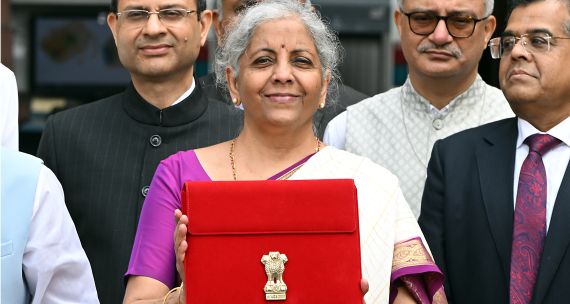The Takeaway
India’s food delivery market has grown rapidly since the dawn of COVID-19, but the backbone of the industry, informal, or “gig economy,” workers, harbour longstanding grievances around income security. Delivery service Blinkit’s recent pay cut for delivery workers prompted widespread protests, highlighting broader concerns around the precariousness of gig work and its impacts on employment and job security in India.
In Brief
Between April 12 and April 20, over 2,500 food delivery workers from Zomato-owned Blinkit went on strike across the country, including in Delhi-National Capital Region, Kolkata, Hyderabad, and Pune, over a recent pay cut reducing the base payment per delivery from C$0.41 (25 Indian rupees) to C$0.25 (15 Indian rupees). This follows a cut in July 2022, when pay was reduced from C$0.82 (50 Indian rupees) to C$0.41. The protests led to the shutdown of over 50 “dark stores,” or facilities where products are stored and packaged for pickup by delivery workers. Despite a one per cent decline in its corporate revenue following the strike, Zomato has not conceded to workers’ demands. Instead, many workers, as of April 21, have resumed work and dark stores have reopened.
Implications
After Zomato acquired UberEats’s India operations in 2020 and Blinkit in 2022, India’s food delivery market became a duopoly, with Zomato holding 55 per cent of the market and Swiggy laying claim to 45 per cent. Between March and May 2020, the COVID-19 pandemic caused disruptions in the market due to consumer skepticism around the safety of deliveries, with restaurants witnessing a 70 per cent decrease in online orders. In response, Zomato and Swiggy expanded their focus to online grocery deliveries and implemented various safe-delivery initiatives. By late 2020, the number of online orders began rising, and by late 2022, it returned to pre-pandemic levels.
The leading players in India’s gig economy — such as Ola, Swiggy, Uber, and Zomato — are expanding operations across the country. Although most companies have been primarily concentrated in urban areas such as Bangalore, Delhi, and Mumbai, due to higher disposable income ratios, companies are now targeting smaller cities with strong potentials for growth. Zomato and Swiggy have also gained a significant share of the Indian market thanks to increasing food delivery adoption rates in both tier I cities (highly populated and developed cities, like Bangalore) and tier II cities (cities with modest populations, like Jaipur). India’s online food delivery sector’s revenue is expected to increase at an annual growth rate of 19.9 per cent between 2023 to 2027. The sector’s largest segment, grocery delivery, is projected to achieve revenue growth of 36.1 per cent in 2024 alone.
Although food delivery workers are essential to sustain such rapid market growth, they face a unique set of challenges. As of 2020, there were 6.8 million gig workers in India, making up 1.3 per cent of the total workforce. By 2030, this number is projected to grow to 23.5 million workers, or 4.1 per cent of the workforce. However, this market does not provide steady labour regulations around minimum hours, working conditions, or collective bargaining rights. And because gig workers are classified as “independent contractors” rather than employees, they are ineligible for income security, medical insurance, and other employment benefits. This lack of status also compounds occupational safety hazards including unsafe road conditions, harassment, and theft, often leading to increased stress and financial instability among delivery workers.
In 2019, a New York Times report exposed American food delivery platform DoorDash’s practice of using customers’ tips to cover the base pay of delivery workers. In response to the backlash, the company raised its base pay in the U.S. from US$1 to US$2 per delivery and stated that tips from customers would be added to the existing base pay. Such a tipping structure could arguably sustain the gig economy in India and curb further protests. However, tipping culture is not prevalent in India.
What's Next
- Can the protests grow bigger?
There have been several protests by food delivery workers across India over the last year, both against Swiggy and Blinkit, in Bengaluru, West Bengal, and Kerala, with demonstrators seeking income security and livable wages. However, these sporadic protests, spanning different Indian states, did not spark any change for workers. While unions such as the Indian Federation of App-Based Transport Workers have launched programs to organize workers, the demographic is yet to gain a strong footing. If gig workers unionized on a larger scale, they could organize a scheduled, country-wide protest, and collectively bargain for income regulations, potentially leading to a more critical market impact on a national level and sustainable growth within the gig economy. However, in most cases, gig workers give in to the need for employment over higher wages as India still deals with unemployment.
- Impacts on job security
Gig workers in India are ineligible to earn minimum wages as they are not defined as “employees” under India’s Code on Wages (2019), which seeks to regulate wages in all sectors. The only code applicable to informal workers is the Code on Social Security (2020), which necessitates the provision of gratuities, employee compensation, insurance, a retirement fund for the worker, and maternity benefits. But state governments have yet to implement the latter code.
• Produced by CAST’s South Asia team: Dr. Sreyoshi Dey (Program Manager); Prerana Das (Analyst); Suyesha Dutta (Analyst); and Silvia Rozario (Analyst).




